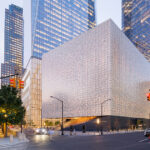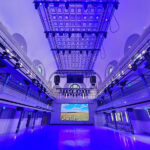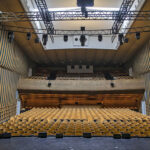Over the past couple of years François Roupinian, principal founder and designer at the Montreal-based lighting firm Lightemotion, has been called on to supply his talents to a wide range of projects. In fact, he’s traveled from Montreal to the States to Singapore to Italy to work on show, museum and event installations, but it was a job in his own backyard last year that might have been the most demanding. In December of 2006, Roupinian received a phone call from visual designer Eric Villeneuve, who had created Les Légendes Fantastiques, an annual stage spectacular of music and dance that had been running in Drummondville for over 10 years. Villeneuve was looking to completely revamp the show and wanted Roupinian’s technical and creative assistance.
“When people hire me or get me involved in a project, they really want the lighting to be a part of the sceneography, so that meant I was involved in the beginning with the writers writing the story. I was trying to bring some lighting ideas and some visual elements that could help sustain the storyline,” he says. “It was a long process with lots of meetings with lots of coffee.”
Once the framework of the story that would become AO The Fantastic Legend was written — changes continued to be made up to about a month before the first curtain was raised — Roupinian and the Lightemotion team got to work designing and installing a new lighting system. “Starting in December we had meetings with the sceneographer. We decided with the director where the action would be on the site and where we could hide and install some lighting,” Roupinian says.
The number-one challenge that the team faced was the venue’s location — outside on the banks of the Saint-Francois River with a forest in the background and a man-made lake on the sprawling stage. Because it’s an outdoor show, with action happening on the stage, in the forest and on the water, Roupinian had to find a way to light the actors without obstructing the view of the audience.
“Most of the lighting comes from sidelights, and we had to install big telephone poles, like booms in the theatre with sidearms, to attach moving lights and waterproof lighting fixtures,” he explains. “The designer who did the show previously had installed all these telephone poles in the back, so he had great back lights. Except, visually, the lighting apparatus was too present. My first goal for that show was to hide the lighting.” The thought process, he adds, was to forget where the positions were and “to make it magical.”
There were a handful of places where the team was able to install lighting in a way that followed Roupinian’s magical dictates. They put lights in the 40 foot tall Tree of Life, in the water, and under some piles of dirt, which the stage designers supplied. The key was to make sure that the audience, seated on rising scaffolding, couldn’t see where the lighting was placed. “We had to calculate each angle to make sure that people didn’t see the source,” he explains. “Everything is hidden.”
Lightemotion’s equipment options were limited somewhat because of a rental contract that Villeneuve had signed during the previous show. But Roupinian made good use of Martin MAC 2000 Profiles, Performances, MAC 600s, Atomic strobes, Color Kinetics Color Blasts and a plethora of custom built waterproof lights with MR16 fixtures. In addition, finger strobes were placed within the Tree of Life for added effect. He wasn’t able to use many gels, he reports, because of maintenance concerns. There are, he adds, a few places where Lekos were installed because a moving light would not fit. Many of the fixtures had to be covered by fiberglass cases to protect the machinery from any harsh weather.
A Compulite Ovation is being used as a controller for the show, which works for Roupinian because he knows the system well and it helps with the flow of the system. “On a show like this, every cue that you see is two or three cues, and because we’re using moving lights, we don’t want to see the movement of the machines,” he says. “So you need a setup cue before your machines are turned on, and a cue at the end to preset them for the next cue.”
While the front of house position is a natural place to hang lights to cover the stage, Roupinian was only able to put two followspots there because the lighting angles made it impractical. There were plans initially to build a new seating area with a roof, where he could have installed more lights, but a few months before the opening, it was deemed too expensive. A pipe was installed on top of the control room, which is at the top of the seating area, where the two spots were placed. But those spots are used minimally.
“We had a large shadow on the floor, so I didn’t want to use [the spots] much,” he says. “The followspot people really hated me at the end of the run, because they had to be really tight on only the faces of the actors, always running at 10 percent, 25 percent. The Color Blasts on the floor and the sides were giving us 80 percent of our light.
“There was never a followspot lighting up the whole actor, because we never wanted to have the circle on the floor,” he continues. “Even the director, because we’re close with him, put the actor in certain positions to make sure the light would hit him. The thing is, the people are so high up, the floor becomes a visual playground, and there’s projection on the floor with lighting and video. So, if we have too many followspot circles on the floor it would be killing the images and the visual.”
Lightemotion was not responsible for the installation of the projection system, but Roupinian worked extensively with the projection designers, who utilized Dataton Watchout software. “We spent two weeks doing light cues alone, and then we spent a week and a half with the projection, always trying to merge” the two, he says. “We really worked together to create a single image. That’s why if you look at the pictures, you can’t tell which is video and which is lighting. It’s really mixed. Watchout is versatile and you can do what you want with the images. So we played with that to match the same color as the lighting.”
Implementing the lighting design for a multimedia show like AO The Fantastic Legend, with its 75 artists, actors, singers, acrobats, dancers and musicians, and also its pyrotechnics and water action, would have been challenging for Roupinian if he could have done it during the day. But because the show takes place after the sun goes down, he had to make sure the design worked at night. That meant he needed to work from 11:15 p.m. to 4 a.m. after the actors had finished their rehearsal. “Then, from 4:15 to 6 we were doing touch-ups that didn’t require total darkness,” he says.
One of the things that made the process easier, he adds, is that the show’s director filmed every rehearsal and then provided Lightemotion with QuickTime movies. “I couldn’t have done that show without that tool,” he says.
The previous installers had used in a system of PVC pipes that were buried around the perimeter of the venue, and that helped the Lightemotion team wire the system cleanly. There is also a system of conduits in the forest and at the front of the stage, Roupinian adds, and there are three dimmer cities on the grounds.
Months after the opening of the show, Roupinian is more than satisfied with the work that was done on this show, especially after he heard from many that he wasn’t going to be able to do what he wanted because the venue was outdoors.
“People told me that I would be fighting the elements and that I would not have time to program,” he says. “But I think if you take the time to prepare yourself for a show like this, you can really go do what you want to do. That’s what stands out [for me] on this project. We can create outside what we could create in a theatre.”


